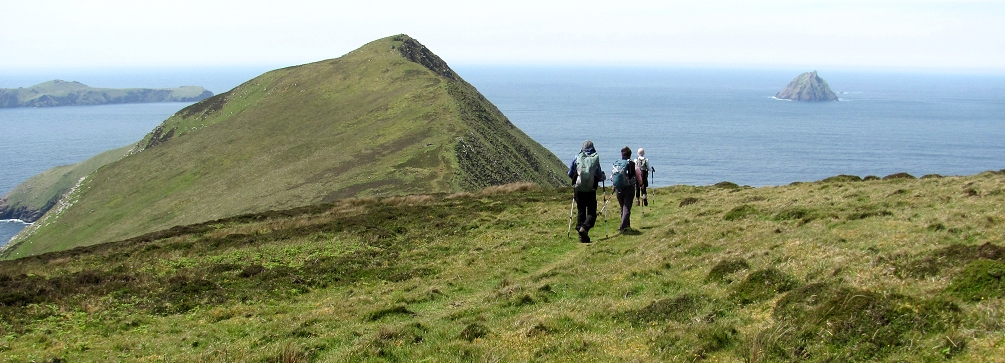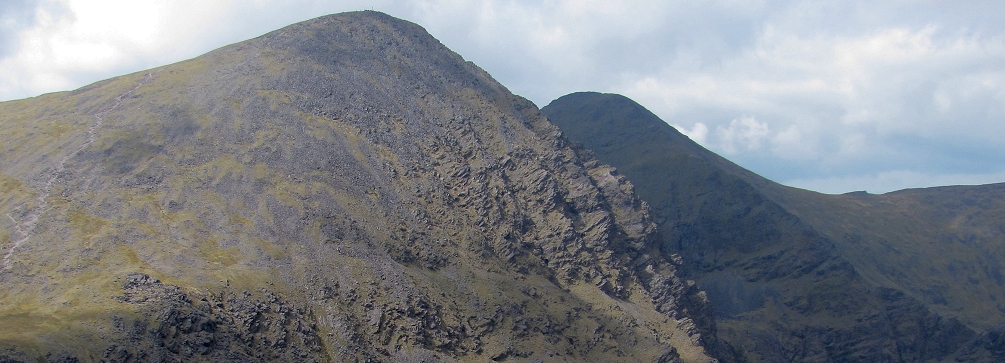Hiking in Western Ireland
Macgillycuddy’s Reeks and the Dingle Peninsula


Discover the beauty of western Ireland on foot as the Irish spring turns to summer. Journey through the lake and woodland landscape of the Killarney National Park, and sample the trails of the MacGillicuddy’s Reeks, a mountain range that contains Ireland’s tallest peak, Carrauntuohill. Continue your Irish adventure on the Dingle Peninsula where stone walls traverse rolling farmland creating the quintessential Irish landscape of patchworked fields. Hike through heather-covered moors, across windswept ridges, past standing stones and ancient monuments, and along the shores of lakes nestled in glacially-scoured cirques. Short boat journeys to offshore islands add another dimension to your travels. After a day outdoors, cozy pubs provide an opportunity to fall into the lively musical rhythms of Ireland!

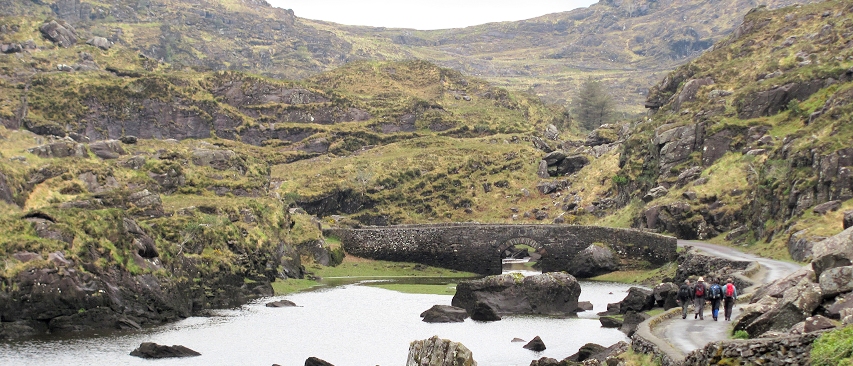
“Walking the Gap.” Hikers en route to the Gap of Dunloe.
Day 1
Overnight in Killarney
Breakfast, lunch and dinner included
Hike through the glacially-carved Gap of Dunloe, a steep-walled valley that slices into the mountain range known as the MacGillicuddy’s Reeks. The way ascends past Black, Cushnavally, and Auger Lakes strung out along the valley floor like a string of beads. From the high point at Head of Gap the route descends to the Upper Killarney Lake (Loch Uachtarach). From there, a small boat will carry you in leisurely fashion across the Lakes of Killarney through the romantic landscapes of the Killarney National Park. Your boat will negotiate a narrow channel that passes under the Old Weir Bridge in a setting oozing with romance! You’ll continue across the Muckross Lake (Loch Mhucrois), passing under the Gothic Brickeen (Bricin) Bridge to enter Lough Leane. Disembark at Ross Castle, one of the finest restored 14th century castles in Ireland. From Ross Castle, a short shuttle ride returns you to your hotel.
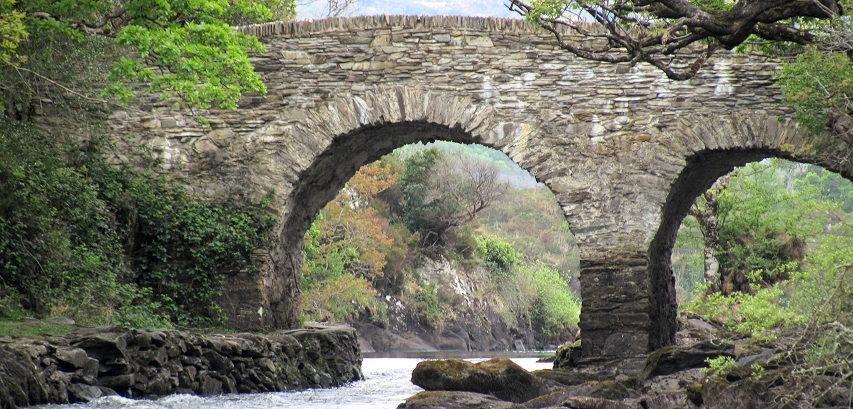
The Old Weir Bridge at Meeting of the Waters, Killarney National Park.
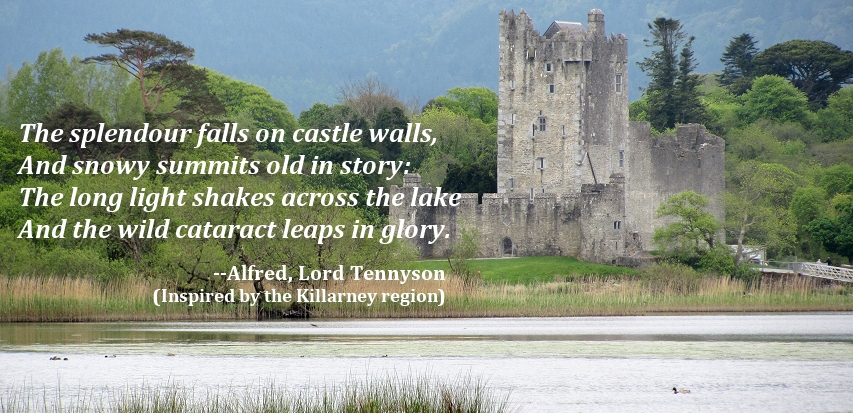
Ross Castle and Lough Leane.

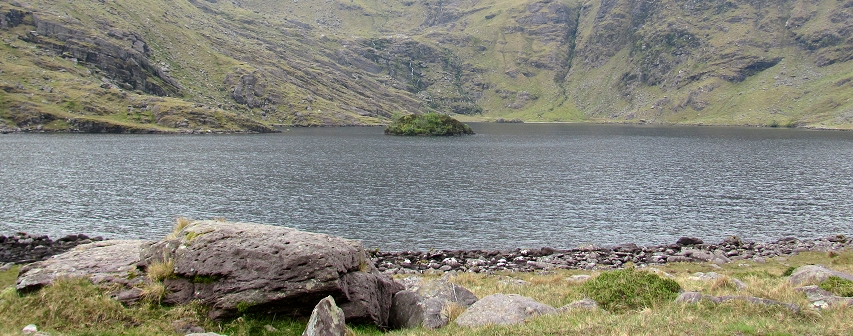
Lough Callee and its small island in Hag’s Glen.
Day 2
Overnight in Killarney
Breakfast and lunch included
Following a track along the Gaddagh River, hike into Hag’s Glen, a glacially-scoured basin sheltering two mountain lakes—Lough Callee and Lough Gouragh—deep in the MacGillicuddy’s Reeks whose Gaelic name, Na Cruacha Dubha, means “black tops.” Beyond the lakes, hardy hikers can undertake the rugged ascent to the summit of Ireland’s highest peak, Carrauntuohill (called Corrán Tuathail in Gaelic, meaning “inverted sickle”). Carrauntuohill’s rugged north face may look daunting, but the hiker’s ascent is via the peak’s sloping south face.
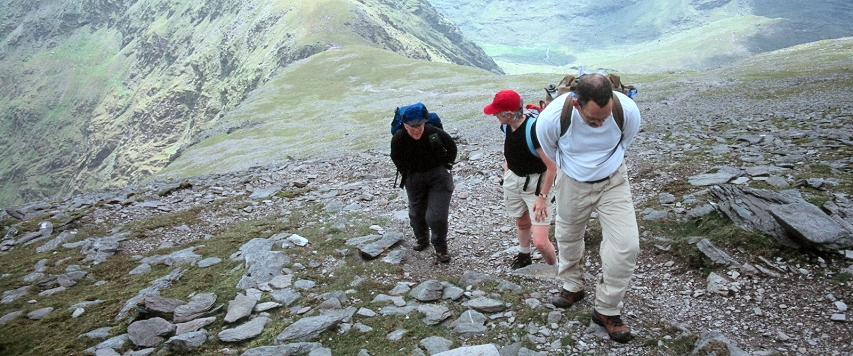
Nearing the summit of Carrauntuohill.

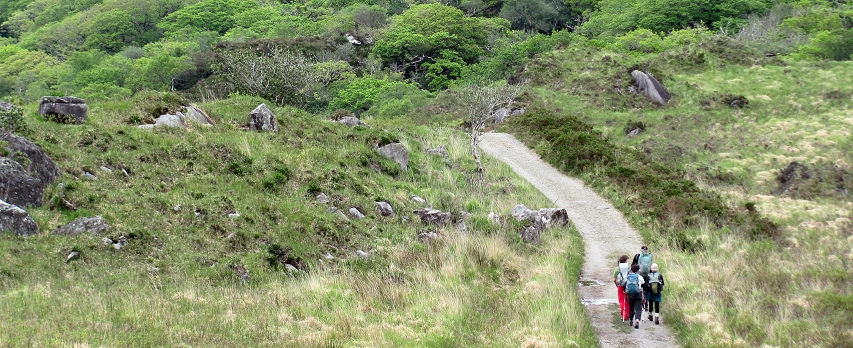
Hikers on the Old Kenmare Road approaching the holly and oak forest of Derrycunnihy Woods.
Day 3
Overnight in Killarney
Breakfast, lunch and dinner included
Hike along the trace of the Old Kenmare Road which once connected the town of Kenmare on the south side of the Iveragh Peninsula with Killarney. Today the old track is the realm of hikers. Cross the well-named Windy Gap and traverse grassy highlands where you can still find the remains of abandoned homesteads. Oak woodlands shade the trail as it ascends the slopes of Cromaglan Mountain to a broad saddle where a narrow boardwalk provides passage through the boglands and into the luminous greenery of tree-shaded Esknamucky Glen. A detour up steep heather-covered mountainsides will bring you to the broad summit of Torc Mountain which offers spellbinding views over the lakes of Killarney. The final portion of the hike descends through woods and rhododendron thickets to the lovely cascade of Torc Waterfall.
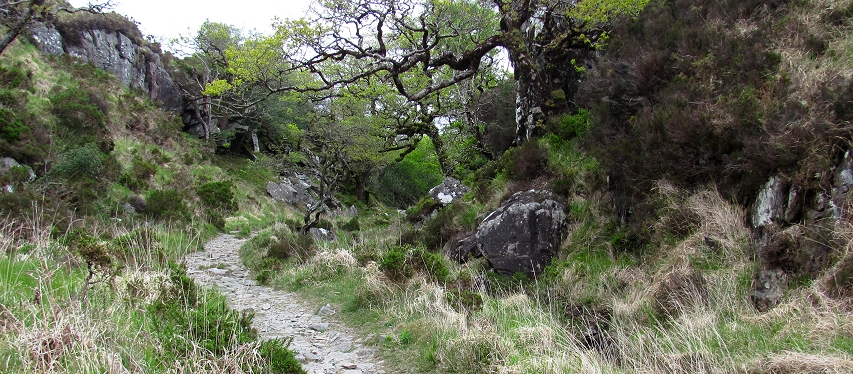
The Old Kenmare Road passing through the Esknamucky Glen.

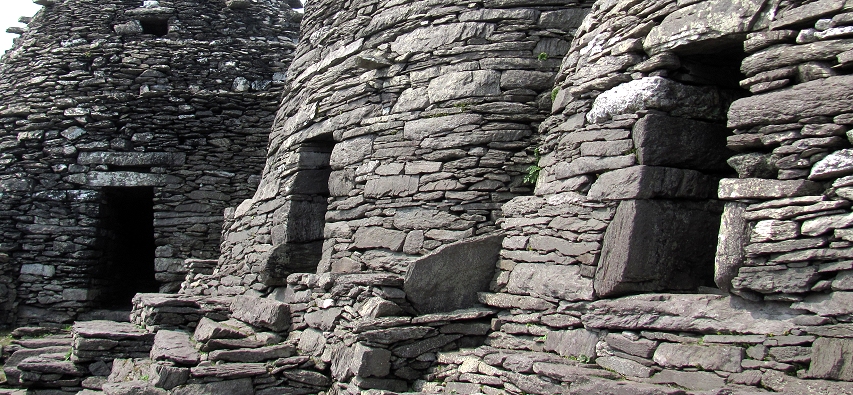
Dry-stone “beehive huts,” or clocháns at the monastic compound atop Skellig Michael.
Day 4
Overnight in Dingle
Breakfast, lunch and dinner included
If weather permits, venture to the island of Skellig Michael, a rocky, sheer-walled pinnacle that rises out of the North Atlantic’s chilly waters 8 miles off the Irish mainland. From Killarney, travel by road along the Ring of Kerry to the harbor at Portmagee at the tip of the Iveragh Peninsula. Board a small boat at Portmagee and cruise by the island of Little Skellig with its 27,000 pairs of nesting gannets en route to Skellig Michael’s rockbound harbor. Follow an easily graded lightkeeper’s path to the base of an ancient stone staircase. Ascend the nearly 600 steps to the monastic complex that crowns the island’s summit 700 feet above the waves. Skellig Michael was named a World Heritage Site in 1996. Here, you can contemplate the life of monks who inhabited this far-flung outpost for 600 years beginning in about 650 A.D. Spend about two and a half hours on Skellig Michael before beginning the return trip to Portmagee from where you’ll travel by vehicle to the town of Dingle on its namesake peninsula.
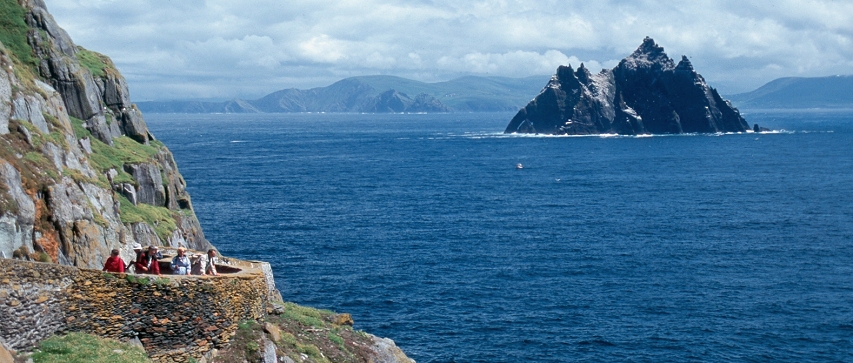
Cliff-hugging path on Skellig Michael.


The dome of Mount Eagle as seen from Ventry Harbor.
Day 5
Overnight in Dingle
Breakfast and lunch included
From your base in the town of Dingle (Daingean Uí Chúis), set off on a hike from an Irish clachan (a term used to describe a cluster of houses smaller than a village) on the slopes of Mount Eagle. Ascend a broad trail to Mount Eagle Lake (Loch Shlaibh an Iolair) cupped in a glacial cirque. From the lake, you can choose to continue on a grassy path that switchbacks up toward Mount Eagle’s broad summit from where you can enjoy glorious views of offshore islands. A descent via a different route returns you to lower elevations.
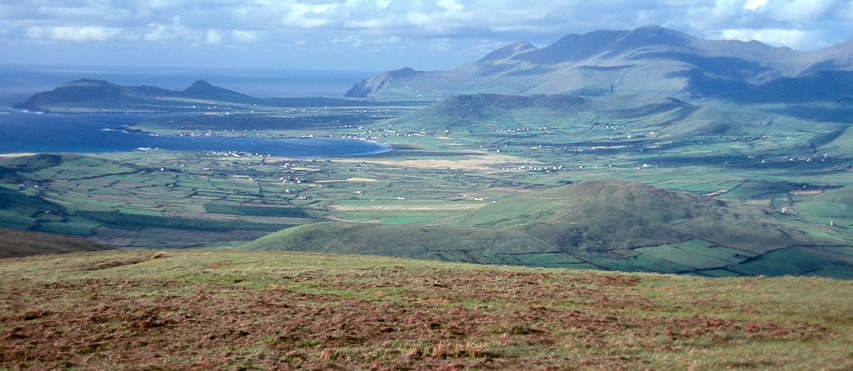
View north toward Mount Brandon from the summit of Mount Eagle.
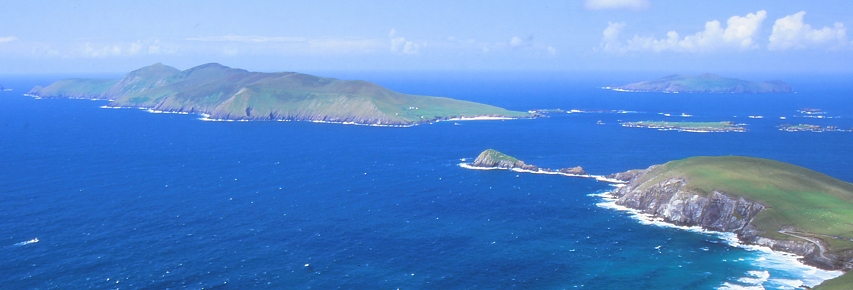
Splendid view of the Blasket Islands from Mount Eagle on a perfect day!


Harbor on the Great Blasket Island.
Day 6
Overnight in Dingle
Breakfast, lunch and dinner included
Weather permitting, travel by boat across Blasket Sound to Great Blasket Island (An Blascaod Mór) off the western tip of the Dingle Peninsula. Great Blasket Island supported a small community until 1953 when the last of the islanders moved to the mainland. Several books (originally published in Gaelic) written by island residents about life in the austere but beautiful environment of Great Blasket have become national icons. Great Blasket Island’s network of gentle, grassy trails offers expansive views and some of the most memorable trail experiences in Dingle. A trail cushioned by grass, moss, and ferns traces the island’s spine and leads to its summit at the grassy peak of Croaghmore, 958 feet above the sea.
For they dwelt on a rock in the sea and not in a shining metropolis
And lived off the pick of the strand, the hunt of the hill, the fish in the sea,
The wool off sheep, and packets full of dollars…
…and the sea roared
In their right ear and the north wind moaned in their left; for they were full
Of sunlight and mist, wind and stone, rain and rock, but the Atlantic ocean
Would not pay them a regular salary; and they did not fret about tumble driers.
–DAVID QUIN in from Pity the Islanders, Lucht an Oileáin
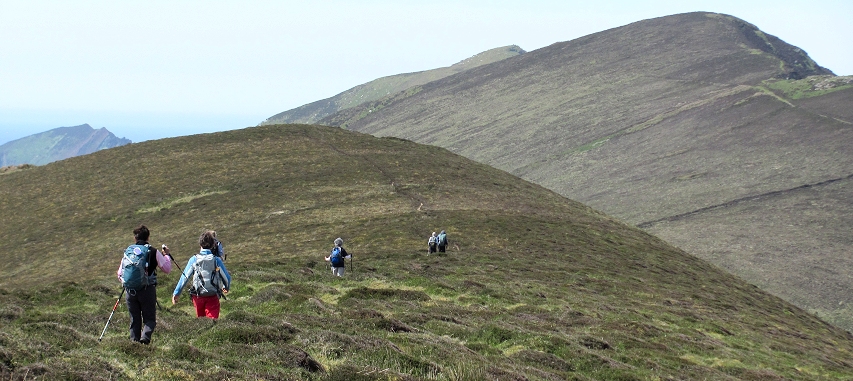
Hikers on Great Blasket Island bound for Croaghmore, the island’s summit.


The head of the Glenahoo Valley from the “green road” from Anascaul.
Day 7
Overnight in Dingle
Breakfast and lunch included
Traverse the Dingle Peninsula on foot starting on a trail along the shores of Lough Anscaul (Loch an Scáil) and continue up into the peaceful beauty of the flat-floored, steep-walled Anascaul Glen. An old, grassy road (known locally as a bothairin, or “green road”) switchbacks up the valley headwall, traverses the spine of the Dingle Peninsula, and descends its northern slope via the magnificent, “U”-shaped Glennahoo River valley. Hike along the beaches of the Magharees Peninsula, a sandy spit that juts into the ocean and separates Brandon Bay from Tralee Bay. Hike along the shores of Tralee Bay, wander through seaside fields, and savor the calm of small fishing villages.

Looking south from the Magharees toward the mountains of the central Dingle Peninsula.


A glorious view from Mount Brandon out to Brandon Bay and the Magaharees.
Day 8
Overnight in Dingle
Breakfast, lunch and dinner included
Explore the high country along the mountainous spine of the Dingle Peninsula. You can choose a walk through open moorlands and along broad ridges east of spectacular Connor Pass to the open summit of Slievanea (Sliabh Mhaca Ré). Revel in 360 degree views that have been called the finest in Ireland. If weather permits, you can attempt a more difficult hike ascending a glacially-carved valley called the Great Eask past a string of lakes to the summit of Mount Brandon (Cnoc Bréanainn), Ireland’s second tallest peak. From the summit, descend via an ancient pilgrimage route. A farewell dinner caps off your Irish adventure. Your breakfast tomorrow morning is included.
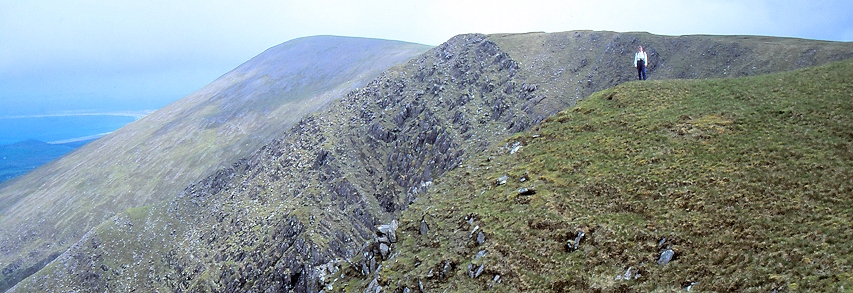
The high open slopes of Slievanea.
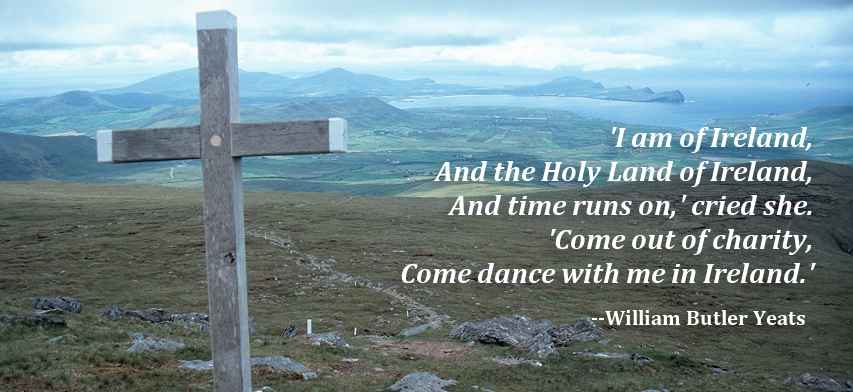
The Saint’s Road on the slopes of Mount Brandon, Dingle Peninsula.


Grassy ridge high above Hag’s Glen, MacGillycuddy’s Reeks.
Other Resources
![]() Read more about Killarney National Park at the official website. The national park is administered by the Irish National Parks and Wildlife Service which is the state agency responsible for the administration of Ireland’s national parks.
Read more about Killarney National Park at the official website. The national park is administered by the Irish National Parks and Wildlife Service which is the state agency responsible for the administration of Ireland’s national parks.
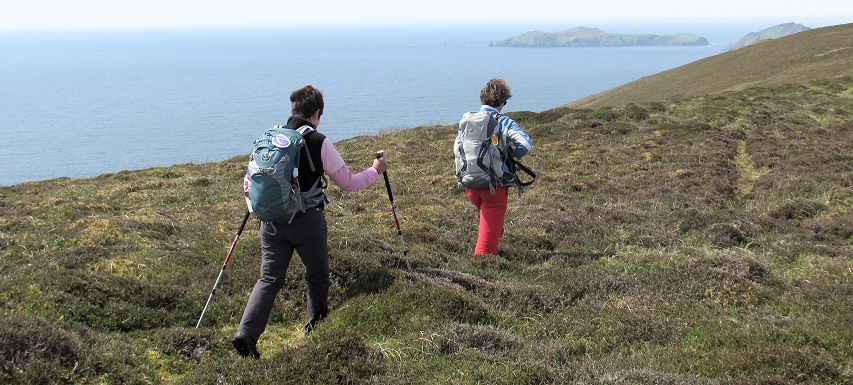
Spring hiking on the Blasket Islands off the Dingle Peninsula.

Visiting Killarney National Park
The core of the Killarney National Park, Ireland’s oldest, is the 10,700 acre Muckross demesne, or estate, donated to the Irish people in 1932 by Arthur Vincent in memory of his late wife. Here are some of the highlights of the park that you can discover on your own if you plan an extra day in Killarney before the trip begins.
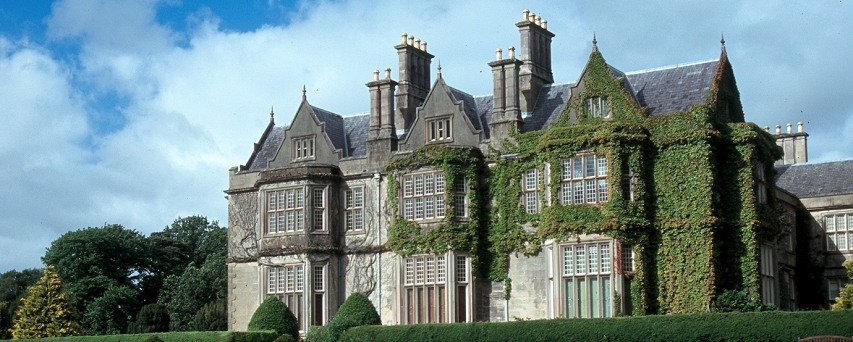
Muckross House, Killarney National Park.
At the heart of the park is the Muckross House, an imposing mansion built between 1839 and 1843 in the Elizabethan Revival style.
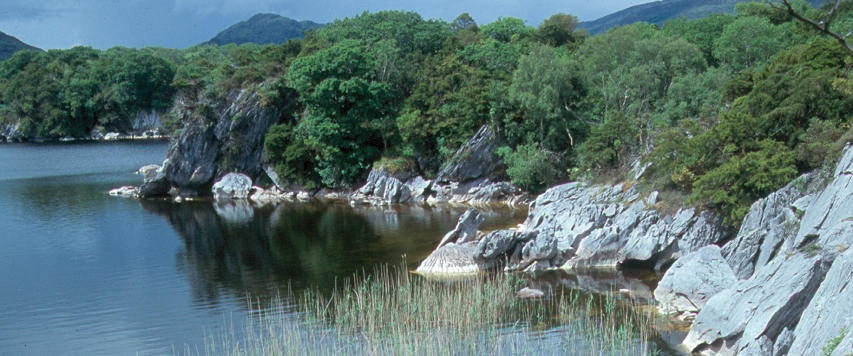
The shores of Muckross Lake, Killarney National Park.
Stroll along the shores of Muckross Lake and wander through deep woods of oak and beech accented by the unusual “strawberry tree” (Arbutus unedo).
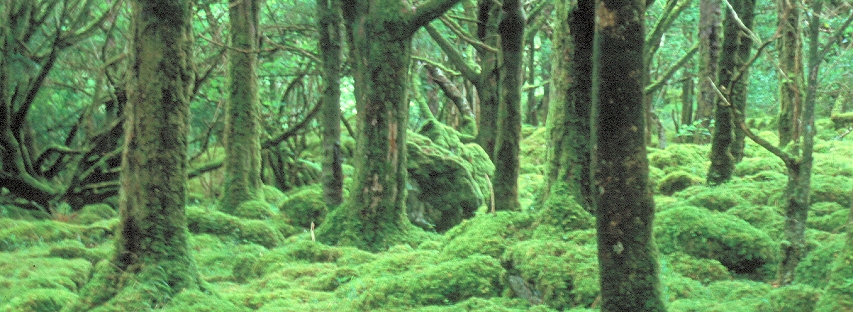
The vibrant green of the Reenadinna Yew Woods, Killarney National Park.
Marvel at the spectacular stand of yew trees in the moss-carpeted Reenadinna Woods, one of Europe’s largest yew woodlands.


Photos on this page are by John Osaki (© All Rights Reserved) except as otherwise credited.


